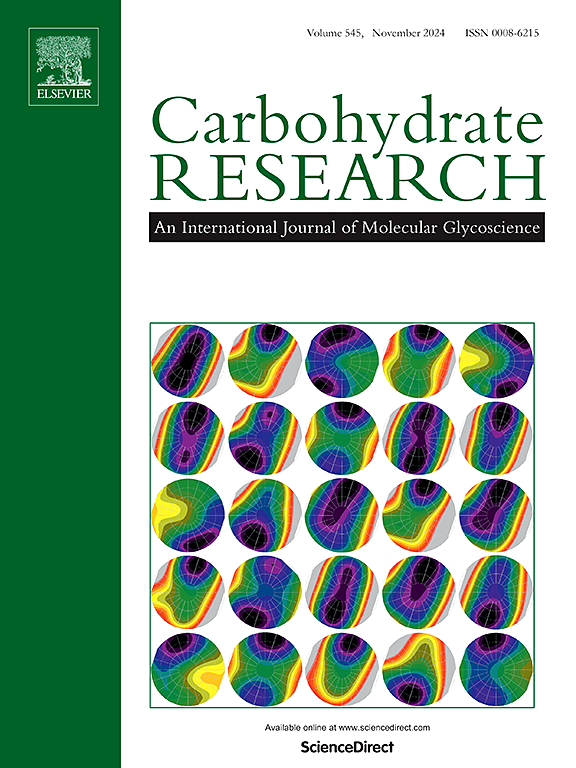利用接近标记法鉴定与GALNT3相互作用的o - galnac修饰蛋白
IF 2.5
3区 化学
Q3 BIOCHEMISTRY & MOLECULAR BIOLOGY
引用次数: 0
摘要
蛋白质糖基化是一种广泛发生的由糖基转移酶催化的翻译后修饰,涉及多种生物学功能。O- n -乙酰半乳糖胺(O- galnac)修饰是由n -乙酰半乳糖胺基转移酶(GALNT)家族催化的,是O-糖基化的截断形式,与多种疾病的发生密切相关。O-GalNAc修饰一直被认为只发生在分泌途径内,仅针对膜和分泌蛋白。然而,最近的研究报道了GALNT3的核定位,这表明O-GalNAc修饰也可能发生在细胞核中。目前,对O-GalNAc在细胞核中的修饰还没有全面的糖蛋白组学表征。在这里,我们采用了一种基于突变生物素连接酶TurboID的有效接近标记方法。通过产生GALNT3与TurboID的融合,在活细胞中进行生物素标记,使与GALNT3相互作用的蛋白质的生物素化成为可能。使用该策略,在26个表征蛋白和4个未表征蛋白中描绘了25个高置信度和10个潜在的o - galnac修饰位点。此外,还鉴定了来自33种不同蛋白质和19种未鉴定蛋白质的52种推定的o - galnac修饰肽。其中大多数是核定位的,并且首次被报道为o - galnac修饰。本文章由计算机程序翻译,如有差异,请以英文原文为准。

Identification of O-GalNAc-modified proteins interacting with GALNT3 using proximity labeling method
Protein glycosylation is a widely occurring post-translational modification catalyzed by glycosyltransferases and is involved in various biological functions. O– N-acetylgalactosamine (O-GalNAc) modification is catalyzed by the N-acetylgalactosaminyltransferase (GALNT) family and represents a truncated form of O-glycosylation, which is closely associated with the development of various diseases. The O-GalNAc modification has long been considered to occur exclusively within the secretory pathway, targeting only membrane and secreted proteins. However, recent study has reported the nuclear localization of GALNT3, suggesting that O-GalNAc modification can also occur in the nucleus. Currently, there is no comprehensive glycoproteomic characterization of O-GalNAc modifications in the nucleus. Here, we employed an efficient proximity labeling approach based on a mutant biotin ligase, TurboID. By generating a fusion of GALNT3 with TurboID, biotin labeling was performed in living cells, enabling the biotinylation of proteins that interact with GALNT3. Using this strategy, delineated 25 high-confidence and 10 potential O-GalNAc-modified sites across 26 characterized proteins and 4 uncharacterized proteins. Additionally, 52 putative O-GalNAc-modified peptides originating from 33 distinct proteins and 19 uncharacterized proteins were identified. The majority of which were nuclear-localized and reported to be O-GalNAc-modified for the first time.
求助全文
通过发布文献求助,成功后即可免费获取论文全文。
去求助
来源期刊

Carbohydrate Research
化学-生化与分子生物学
CiteScore
5.00
自引率
3.20%
发文量
183
审稿时长
3.6 weeks
期刊介绍:
Carbohydrate Research publishes reports of original research in the following areas of carbohydrate science: action of enzymes, analytical chemistry, biochemistry (biosynthesis, degradation, structural and functional biochemistry, conformation, molecular recognition, enzyme mechanisms, carbohydrate-processing enzymes, including glycosidases and glycosyltransferases), chemical synthesis, isolation of natural products, physicochemical studies, reactions and their mechanisms, the study of structures and stereochemistry, and technological aspects.
Papers on polysaccharides should have a "molecular" component; that is a paper on new or modified polysaccharides should include structural information and characterization in addition to the usual studies of rheological properties and the like. A paper on a new, naturally occurring polysaccharide should include structural information, defining monosaccharide components and linkage sequence.
Papers devoted wholly or partly to X-ray crystallographic studies, or to computational aspects (molecular mechanics or molecular orbital calculations, simulations via molecular dynamics), will be considered if they meet certain criteria. For computational papers the requirements are that the methods used be specified in sufficient detail to permit replication of the results, and that the conclusions be shown to have relevance to experimental observations - the authors'' own data or data from the literature. Specific directions for the presentation of X-ray data are given below under Results and "discussion".
 求助内容:
求助内容: 应助结果提醒方式:
应助结果提醒方式:


